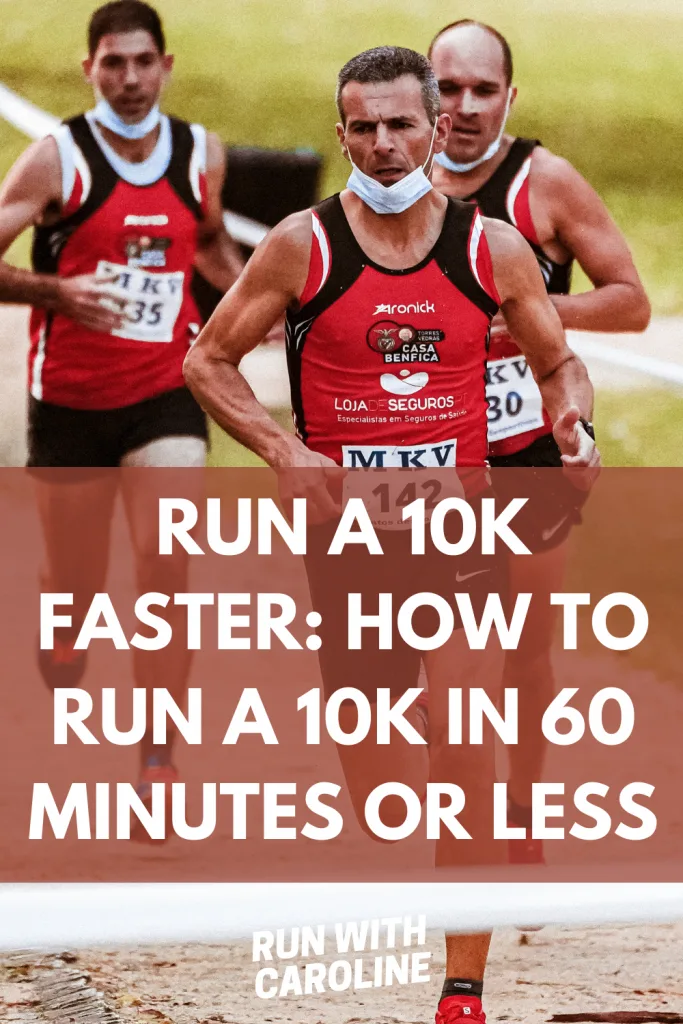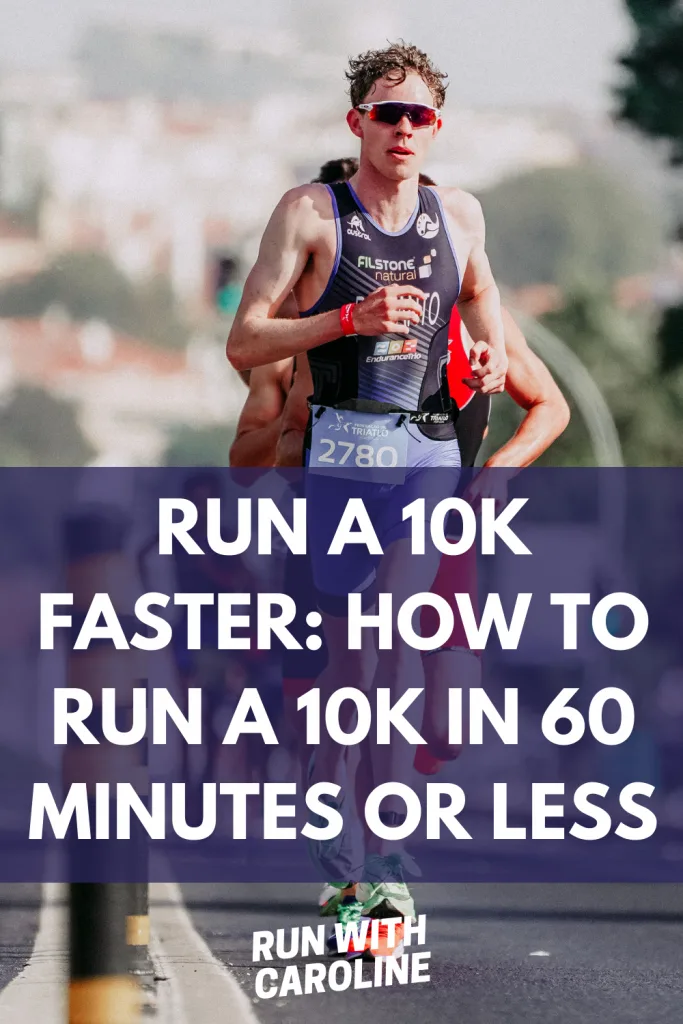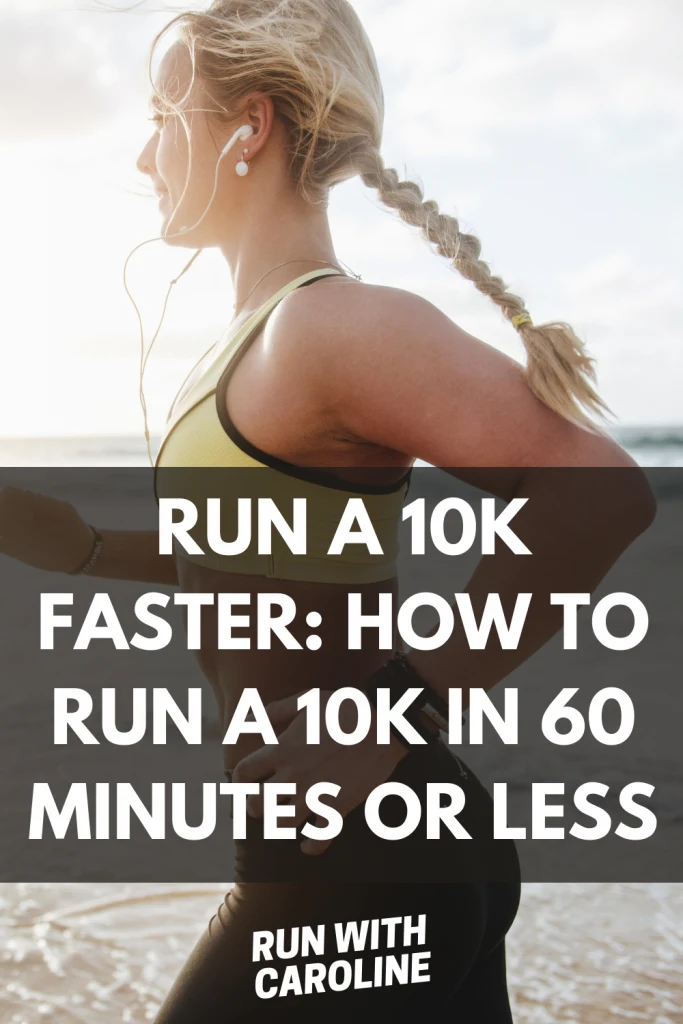A 10k is a milestone distance for every runner, and sooner rather than later you will probably want to set yourself a goal to run a faster 10k.
How you run a 10k is completely up to you, but there are a few tips and training techniques that will help you run a faster 10k in 60 minutes or less.
At 6.1 miles, a 10k is quite a sizeable distance, and one that you have to put in a decent amount of training into in order to finish it in under 60 minutes.
Over the years as a runner, I’ve come to realise what works and what doesn’t work when it comes to running faster.
Gone are the days when I thought pounding the pavement for miles and miles on those long, slow runs would make me a faster runner.
Granted, it would increase my endurance and stamina and make me faster in the short term, but in the long term I wasn’t seeing any improvement in my race times.
If you’ve never run a 10k before, or your best time is well over 60 minutes, then you may need an extra helping hand to see some real improvement in your times.
In this guide we’ll explore:
- How many miles is a 10k?
- What is the average time to run a 10k?
- How to run a 10k in 60 minutes or less
- How to find a suitable 10k training plan
- How to run a faster 10k: 8 training tips
Ready?
Let’s get going!

How many miles is a 10k?
A 10k in miles is 6.2 miles.
This is exactly double the distance of a 5k which is 3.1 miles.
Related: How many miles is a 10k? Average 10k time + 9 10k training tips
What is the average time to run a 10k?
The average time to run a 10k is dependent on factors like your age, gender and fitness levels.
If you’re a 25 year old male, for example, the average time to run a 10k is 53:31.
Whereas if you’re a 30 year old female, the average time to run a 10k is 1:02:31.
Related: Run a faster 10k: What is the average 10k time?
How to run a 10k in 60 minutes or less
In order to run a 10k faster in 60 minutes or less, you need to run at a pace of at least 9:39 minutes per mile or 6:00 minutes per kilometre.
If this sounds unachievable to you right now, then consider a training plan that will allow you to work on your pace over a series of weeks.
Many runners go on to run a 10k having completed their first 5k or a few 5k races such as Parkrun.
At 3.1 miles, the 5k is half the distance compared to a 10k which means you will have to approach a 10k differently, especially when it comes to pacing.
You can’t run at your 5k race pace during a 10k as you will risk tiredness, fatigue and burnout.
This is why it’s so important to pace your 10k run properly.
The easiest way to do this is to use a running pace calculator. A pace calculator will help you determine your 10k pace based on any two variables – pace, time or distance.
Related: How to pace your run

How to find a suitable 10k training plan
A well-rounded training plan will include easy runs and long runs as well as activities like speed training and strength training to make you become a stronger and faster runner.
When running a 10k, it’s not always about endurance and stamina.
Whilst these are important, you need to be focusing on your speed and power to really allow you to improve your race times.
There are many 10k training plans out there and the key is to find a training plan that suits your fitness levels, fitness goals and lifestyle.
There are three core types of 10k training plan:
- Beginner 10k training plan
- Intermediate 10k training plan
- Advanced 10k training plan

Run a 10k faster: How to run a 10k in 60 minutes or less
#1 Speed train
Speed training (also known as speedwork) is a great way to improve your speed, stamina and endurance as a runner. It also helps to improve your performance, form and efficiency.
Strides, Fartlek running, tempo running and interval running are all forms of speed training.
All these types of training push you out of your comfort zone and get you to used to running at a faster pace over longer and sustained efforts.
Your body benefits from running at different paces, as it can quickly get used to a steady pace, so if you’re used to just running at a slow duration, it may be a sign to switch things up a bit!
Doing speed training one or two times a week can dramatically increase your running times.
If you’re new to speedwork, a good beginner speed workout is strides.
Strides are short bursts of high intensity running, like sprinting, in between easy runs and recovery runs.
- Run 45 minutes at an easy pace that feels like a 4 or 5 out of 10 on the intensity scale. You should be able to hold a conversation without getting out of breath.
- Finish your run with 4 x 20-second strides on a track, flat road or field at max effort (think 7 or 8 out of 10), with 30- to 45-second recovery jogs in between.
Related: 11 Fartlek training advantages and disadvantages
#2 Don’t forget about the long run
Whilst speed training is important to help you increase your speed, long, slow runs are still important when training to run a 10k faster.
Long runs at an easy pace are essential to improve and maintain your endurance and stamina.
Combining long, slow runs with speed training, strength training and easy runs to aid recovery are all essential ingredients to a good training plan.
Related: 6 mental tips for long runs
#3 Strength train
Strength training should be part of any training plan, no matter the distance.
It makes you a stronger runner and helps prevent those common running injuries that many runners suffer from.
Any form of exercise that involves some kind of resistance, whether that be in the form of your own bodyweight or external resistance using equipment like dumbbells or kettlebells can be considered strength training.
A well-rounded training plan should include strength training to ensure you are building muscle to replace the muscle broken down through running, which is a form of cardio exercise.
Compound movements (also known as ‘all body’ movements) work really well for runners. Deadlifts, squats, lunges, push-ups, glute bridges and planks are some good examples of compound movements.
Related: 30 day strength training plan for runners

#4 Run up hills
Hill running is another great way to build your endurance, strength and power as a runner and help you run a 10k faster.
Running up hills uses different energy systems than long, steady running and involves much more explosive movement to get your body up the hill.
Explosive movement and power are important when it comes to speed.
- Run up a hill of 100-200 metres long at your 5k pace, then recover running or walking downhill.
- As you approach the hill, make sure your arms are at a 90-degree angle and moving forward and back (not across your body).
- Your back should be straight. You can lean very slightly forward from the hips as you run up the hill, but make sure you’re not hunched.
If you’re a beginner runner, I suggest you do 2 to 3 hill repeats but only after you’ve got a good base level of fitness.
Hill repeats are not for the faint hearted – so take them in your stride!
Adding hill repeats into your training will translate to better form and faster times—even on flat land.
So even though they feel horrendous when you’re doing them, they will pay off in the long run.
Related: 3 hill running workouts that increase your power and speed
#5 Perfect your form
Believe it or not, proper running form can shave valuable seconds off your running times and will go a long way to help you run a 10k faster.
By making small adjustments to your posture and form, you can help your body move with less effort.
Many components from form, footstrike to breathing come together to create optimal running form and posture.
By training your body to run in ways that puts the least strain on your joints, supporting muscles and ligaments during movement, you will become faster.
So what does good running form look like?
- Try not to look at the ground when running – keep your gaze upright and forward.
- Lift your chin and retract your shoulders back slightly.
- Swing your arms and try to keep your elbows at a 90 degree angle.
- Keep your arms by your sides and try and not let them cross your body.
- Drive your elbows back, keep them close to the sides of your body and keep them relaxed to avoid stiffness in your shoulders.
Related: The ultimate guide to head to toe running form and technique

#6 Strengthen your core
Your core is extremely important when running. A good core means you are able to hold a strong and stable position for longer, thus allowing you hold proper form and posture.
Your back and stomach muscles are key components for good core strength.
Unfortunately, running alone won’t improve your core strength, you need to dabble in core strength exercises as well as running to really see results.
There are lots of core strength exercises you can do to improve your core strength, including hollow body holds, Superman pulls and planks.
Related: 7 essential core exercises for runners
#7 Allow adequate time for recovery
When training for your next race, the temptation is to run every day. Although this may appeal to some runners, overtraining is a huge factor when it comes to increased rates in injury and runner burnout.
Allow adequate time for recovery after each run – at least one day per week. Your training plan should have at least 2 to 3 rest and recovery days.
Activities like stretching, yoga, foam rolling are all great activities to do a your rest day.
Related: 11 symptoms of overtraining when running: How to overcome running fatigue
#8 Improve your eating habits
As with any form of exercise, running is nothing without proper nutrition.
A 1995 study found that carbs should provide approximately 60-70% of a runner’s daily energy intake, whereas protein should provide approximately 12-15%, with the remainder provided by fat.
Before you go carb crazy, remember that high carb intake (or ‘carb loading’) is only recommended before a race, immediate recovery from or during heavy training periods.
If you’ve set your sights on a PB but you’re not seeing any improvement on the race track, then now may be a good time to re-assess and improve your nutrition and eating habits.
- Are you consuming enough protein? Protein is essential when it comes to muscle repair and recovery.
- Are you eating enough carbs? Carbohydrates are important when it comes to fueling your runs.
- Are you consuming enough healthy fats? Fats are essential for good joint health.
- Are you eating enough vegetables? Try and incorporate veggies in every meal.
- Are you drinking enough water? Hydration is key to running performance.
One of my favourite ways to ensure I get a good dose of vitamins and minerals is by drinking smoothies.
Related: 6 nutritious and delicious smoothie recipes for runners
- 5 things I wish I’d known before returning to running - March 3, 2024
- Running 20 minutes a day: Benefits + how to start - January 27, 2024
- How to run your first 2 hour half marathon - January 16, 2024
